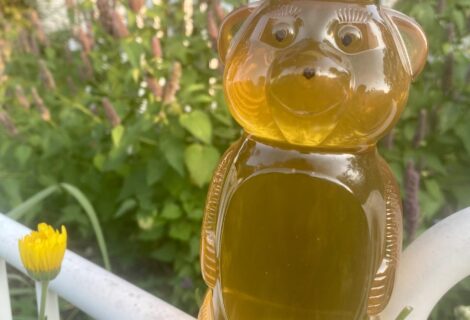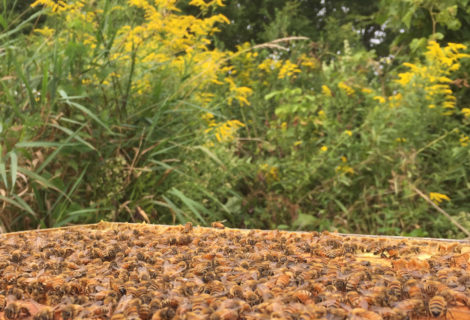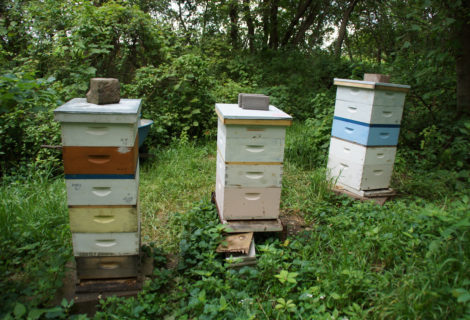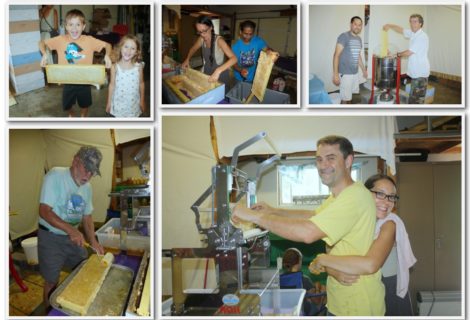End-of-year wrap-up
We have a lot to be thankful for as we look back on 2018. It amazes me how quickly it has drawn to a close. Below you will find some miscellaneous updates on the bees and our honey business.
How did we winterize the hives?
 This year we did not wrap the hives. In the first picture, our tallest hive is in the foreground. There is an entrance at the bottom that is set to a small opening with a 1/2 inch hardware cloth mouse guard either in front or behind the entrance. Above that are the hive bodies the bees live in through the winter – 5 medium boxes in this case. We put on a “quilt box” on the top. It has a screened bottom and either wood chips or straw/hay inside to trap moisture along with an insulation board. Above that is the outer cover, followed by a steel overhang to help keep snow off the entrance.
This year we did not wrap the hives. In the first picture, our tallest hive is in the foreground. There is an entrance at the bottom that is set to a small opening with a 1/2 inch hardware cloth mouse guard either in front or behind the entrance. Above that are the hive bodies the bees live in through the winter – 5 medium boxes in this case. We put on a “quilt box” on the top. It has a screened bottom and either wood chips or straw/hay inside to trap moisture along with an insulation board. Above that is the outer cover, followed by a steel overhang to help keep snow off the entrance.
The next two photos show the quilt box contents. Some have a middle section with absorbent material that can be removed to feed the bees through the screen if the weather allows.
We are currently in the middle of deep freeze here at the end of December and going into January. This is definitely hard on the bees to have such an extended time of cold and below zero temperatures. They need to move to new locations in the hive to get at honey, and moving is quite difficult when it remains cold. Because of some sunny days, they probably could have benefited from black tar paper wrapping on some sun-facing sides of the hives. We had issues last year with having the hives wrapped through some relatively warm weather though and opted not to do it this year. One just can’t predict the temperature patterns.
What is the Chuck-O-Comb honey?
The bees did not produce comb honey for us this year (we’ll try again next year), but we did put some chunks of comb in a few jars of honey and that is what can be seen on our shop as a special kind of order.
How did the creamed honey go?
It went great! We actually made a lot more creamed honey this year than last, so we have plenty available that you can link to on our shop. In the photo, the creaming process has started by mixing a “starter” into the honey and then putting it into containers, where it will “firm up” the rest of the way. The starter creamed honey is kind of a crystallized solid, but with very fine crystals so that it is smooth, easier to work with, and spreadable (at warm enough temps in your house). If you run your house in the mid-60s during winter though, you might find it pretty stiff yet 🙂 In a few weeks the smooth crystallization process naturally works its way through the whole batch. In addition to regular creamed honey, we have a couple flavored varieties available.
What is a “honey house”?
A honey house is a spot where you can uncap frames, spin, and bottle honey – along with storage for beekeeping equipment and other items. There is a “rumor” that we are getting one! Actually, it is more than a rumor. Carl’s dad, Clair, has been working hard on an addition to their house that can serve this purpose. It is quite the undertaking and major news for us, so I plan to have a future post that will give more details and progress on this facility.
Do you have mice problems?
This last bit is just something to smile at. Sometimes I have to set traps in our garage because the mice look for ways in when it starts getting cold. Well, I have not caught any since an incident earlier in the fall. A chicken knocked a jar of honey off a shelf, and I did not discover it until a couple days later. This was what I found. A couple mice gorged themselves to death on the sweet stuff. Perhaps there is a lesson in this somewhere?












Recent Comments